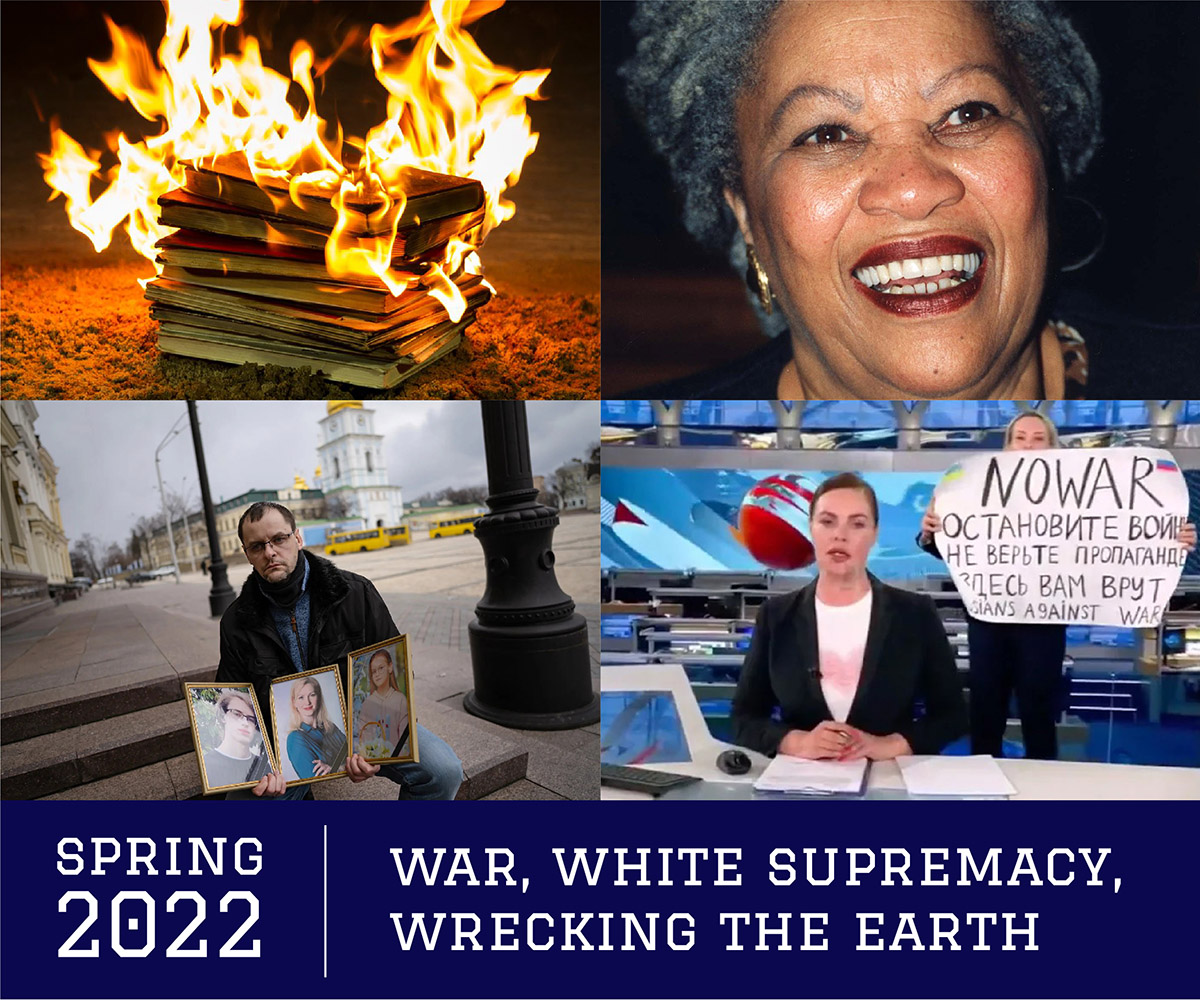
Photo credits, clockwise from upper left: Time Magazine, Wikipedia, CBC, The Boston Globe
by NEINA GORDON
The daily news stream of Russia’s invasion of Ukraine, the derisive rhetoric aimed at Ketanji Brown Jackson during her confirmation hearing, Will Smith slapping Chris Rock at the Oscars. That was enough for the week. That was enough shock and/or dismay to take in and digest. Reading the news requires that I remind myself of its inherent negativity bias; I do this, not to deny the heinousness of the war going on or the political and personal tensions that manifest in bizarre and disturbing public behavior, but to curb overwhelming feelings of anger and helplessness. After being swept up by the powerful and persistent information stream that I carry in my pocket, I actively go searching in publications like The Sun, Electric Literature, or wherever I can find a compelling essay, poem or story that offers perspective and insight into our humanity, to help me rebalance. But recently I scrolled through The New Yorker on my phone and completely lost my balance when I clicked on “The Mystifying Rise of Child Suicide,” by Andrew Solomon (The New Yorker, April 11, 2022, issue). There is so much we can point to that reflects the toxicity of our current age, but nothing is more revealing of that toxicity than children taking their own lives.
Child suicide scrapes us out from the inside; in one swoop we’re hollow—we are left without our children and with the gaping question: why? It’s the why and what can we do that keeps me up at night. As adults, it’s challenging to navigate the tensions in our society and within ourselves, but for children, it’s simply not possible for them to navigate the world and their inner world without us, and we’re failing. They look to us, or they’re supposed to, but what do we have to offer? On a collective level our modeling sucks—to put it bluntly. Ever since Trump entered office and our enormous shadow took center stage, we’ve become so polarized we’ve lost the ability to be civil. Those of us who took Obama’s presidency as a sign that we were becoming a more tolerant, accepting society learned we were mistaken as we witnessed an uptick in hate crimes, and previously unacceptable rhetoric become normalized. And just when we thought the partisanship in our country couldn’t get worse, we entered a pandemic and mask mandates became a political issue instead of what they were meant to be, a measure of protection. This is the environment we’re living in and even when we try to protect our children from its toxic nature, it trickles in.
Many of us, even some republicans, breathed huge sighs of relief when Biden was elected, but the tension, the hate, the intolerance is all still here. We have experienced an unprecedented amount of stress and trauma the past five years, and no one more than minorities. In his article, Solomon cites a 2018 study that “the suicide rate among Black children between the ages of five and twelve is double that of white children.” A sobering statistic for those of us who forget racism exists or the general lack of resources and support for minority populations. Children are permeable, and the collective values and tensions will influence them whether we like it or not. Their pain is real, and they do not have the benefit of perspective that age provides. Solomon states, “the omnipresence of social media has created new venues for bullying,” and cites a finding from a psychology professor at San Diego State University “that teens who spend five or more hours a day online are nearly twice as likely to have suicidal tendencies as those who spend less than an hour.” Parents can only approach collective influence through our individual choices. We need to check what’s influencing us. What are we bringing home? What are we exposing them to? Are we keeping our own despair in check? How do we communicate perspective? Are we taking our own well-being seriously or are we getting caught up in the dramas we are bombarded with every day? Are we practicing acceptance and compassion? Are we present? How do we create a safe space? Because that space is essential, and it starts with us.
One cannot point to any single cause of child suicide. Like everything it is complicated, and there is a myriad of factors to consider when trying to find reasons and make sense of the senseless. It brings up so many emotions and questions. Unlike many injustices we face where we feel rage, child suicide seems to smother that rage. Rage seeks to blame and only has benefits when we channel it into positive action, such as we’ve seen with protests the past few years. A protest gives our collective rage a voice and direction. We can protest the war in Ukraine. We can protest racism, violence, lack of gun control, the list goes on and on. How do we protest child suicide? At whom or what do we aim our rage? It brings us to our knees. If you can stomach the read, Solomon’s article is a first step towards what we can do by the mere fact it raises our awareness. One of the most striking findings he makes is “Children who are both bullies and victims are particularly predisposed to suicide, with nearly half reporting a suicide attempt or self-harm.” The pain is on both sides. We naturally express more sympathy for victims and often disdain for bullies. It’s difficult to garner sympathy for bullies when their response to pain is to inflict it on others, however; If we can’t muster sympathy then perhaps we can suspend our judgment and at least recognize it may be a cry for help. Our polarized world takes its toll on all of us, and it is important to keep in mind none of us is exempt from suffering.

